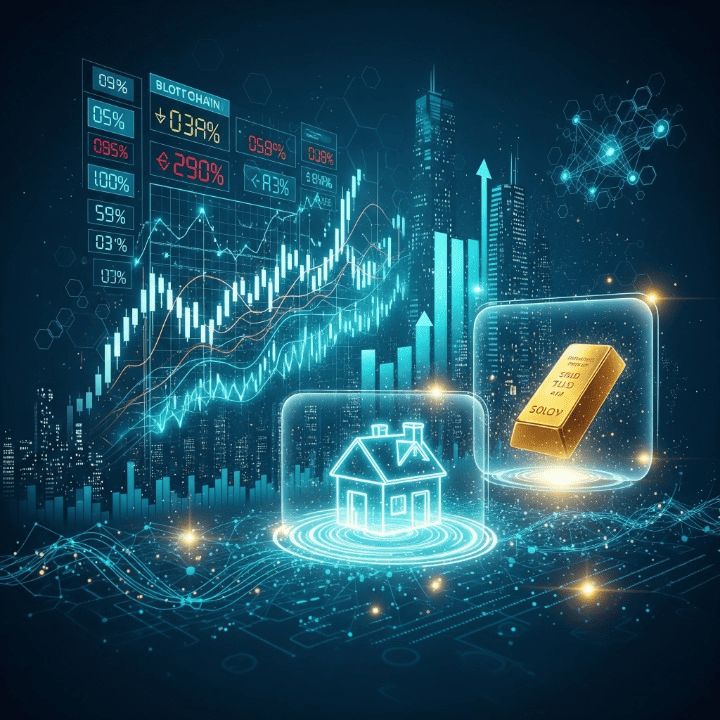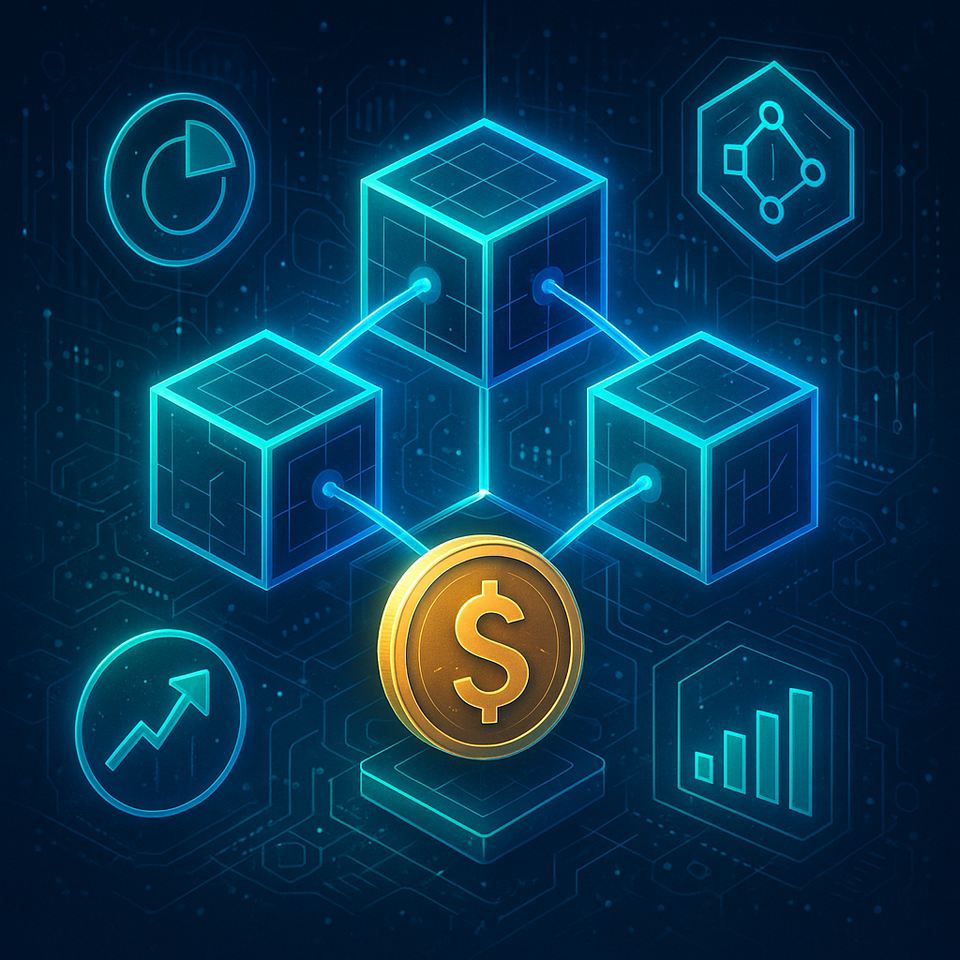
Introduction
The global financial landscape is constantly evolving. Traditional financial systems often present challenges for many investors. These include high transaction fees and limited access for a significant portion of the global population. Bitcoin initially disrupted this paradigm. It introduced the concept of digital scarcity and peer-to-peer transactions. However, the innovation did not stop there. We are now seeing the rise of Decentralized Finance (DeFi). This movement builds on blockchain technology. It aims to create an open, accessible, and transparent financial ecosystem. Furthermore, Real-World Asset (RWA) tokenization is emerging. It promises to bridge physical assets with the digital realm. This article explores these transformative concepts. It highlights their potential impact on investment strategies and financial planning.
Understanding Decentralized Finance (DeFi)
Decentralized Finance, commonly known as DeFi, represents a new frontier. It operates without traditional financial intermediaries. These include banks, brokers, and exchanges. Instead, DeFi utilizes blockchain technology. It relies on smart contracts for automated transactions. This paradigm shift offers enhanced transparency and immutability. It fundamentally changes how financial services are delivered globally.
What is DeFi?
DeFi refers to an ecosystem of financial applications. These applications are built on public blockchains. Ethereum is the most prominent platform. The core idea is to replicate traditional financial services. Examples include lending, borrowing, and trading. However, they are created in a decentralized and permissionless manner. This means anyone with an internet connection can participate. There is no need for identity verification. It promotes financial inclusion for everyone.
A key characteristic of Decentralized Finance is its open nature. All transactions are recorded on a public ledger. This provides full transparency. Smart contracts automate agreements. They execute automatically when conditions are met. This removes the need for trusted third parties. It significantly reduces operational costs and potential human error.
Core Pillars of DeFi
The DeFi ecosystem comprises several crucial components. These components work together. They form a comprehensive alternative to traditional finance. Understanding these pillars is essential. It helps grasp the full scope of decentralized finance.
- Decentralized Exchanges (DEXs): These platforms allow users to trade cryptocurrencies directly. They do not require an intermediary. Users retain control of their funds. This reduces counterparty risk significantly.
- Lending and Borrowing Protocols: These protocols enable users to lend out their crypto assets. They can earn interest. Conversely, users can borrow funds. This is typically done by providing collateral. Interest rates are determined by supply and demand.
- Stablecoins: These are cryptocurrencies designed to maintain a stable value. They are often pegged to a fiat currency like the US Dollar. Stablecoins reduce volatility. They facilitate transactions within the DeFi ecosystem.
- Yield Farming and Staking: These are strategies to earn rewards. Users provide liquidity to DeFi protocols. They can also lock up their crypto assets. This helps secure a blockchain network. These methods offer opportunities for passive income.
Advantages and Risks of DeFi
The adoption of Decentralized Finance brings numerous benefits. It also introduces specific risks. Investors must understand both sides. This ensures informed decision-making.
Advantages:
- Accessibility: DeFi services are available to anyone. They require only an internet connection. This eliminates geographical barriers.
- Efficiency: Transactions are often faster. They can also be cheaper than traditional finance. Smart contracts automate processes.
- Transparency: All transactions are verifiable on the blockchain. This fosters trust. It reduces the potential for fraud.
- Innovation: The open-source nature encourages rapid development. New financial products emerge constantly.
Risks:
- Volatility: Most cryptocurrencies are highly volatile. This can impact collateralized loans.
- Smart Contract Risks: Bugs or vulnerabilities can lead to loss of funds. Audits help but do not eliminate risks.
- Regulatory Uncertainty: The legal landscape for DeFi is still developing. This poses compliance challenges.
- Complexity: Understanding DeFi can be challenging for newcomers. It requires technical knowledge.
Real-World Asset (RWA) Tokenization Explained
Beyond the native digital assets, Real-World Asset (RWA) tokenization represents another significant evolution. It connects the tangible world with blockchain technology. This process has the potential to unlock immense value. It transforms illiquid assets into tradable digital tokens. It is an important part of the future of decentralized finance.
What is RWA Tokenization?
RWA tokenization is the process of creating a digital representation. This representation is of a tangible asset on a blockchain. Essentially, an RWA token is a digital certificate. It proves ownership or a fractional share. This share is linked to a physical asset. This could be anything from real estate to fine art. Even commodities and company equities can be tokenized. The legal framework supporting the token is crucial. It ensures its validity and enforceability.
The underlying asset is typically held by a custodian. This custodian ensures its physical existence and maintenance. Smart contracts then manage the token. They define ownership, transfer rules, and other associated rights. This creates a seamless digital layer. This layer represents the physical world. It opens up new avenues for investment strategies and ownership.
The Benefits of Tokenizing RWAs
Tokenizing real-world assets offers several compelling advantages. These benefits address long-standing limitations. They improve traditional asset markets significantly. This enhances their appeal to a broader investor base.
- Increased Liquidity: Many traditional assets are illiquid. Real estate is a prime example. Tokenization allows for fractional ownership. This makes assets divisible and easier to trade. It greatly enhances market liquidity.
- Enhanced Accessibility: Fractional ownership lowers the entry barrier. Investors can own a piece of a high-value asset. They do not need to buy the entire asset. This democratizes access to exclusive investment opportunities.
- Improved Transparency and Efficiency: Blockchain technology provides immutable records. This ensures clear ownership trails. It automates transfers. This speeds up settlements. It also reduces administrative overheads.
- New Investment Opportunities: Investors gain access to diverse asset classes. These were previously hard to invest in. This allows for greater portfolio diversification. It opens doors for innovative financial products.
Challenges and Considerations for RWA Tokenization
While promising, RWA tokenization faces unique challenges. These must be addressed for widespread adoption. Understanding these hurdles is critical for stakeholders. It ensures a robust and compliant ecosystem.
- Regulatory Hurdles: Different jurisdictions have varying laws. These pertain to asset ownership and digital securities. Navigating this complex legal landscape is essential. It requires careful compliance.
- Valuation and Legal Enforceability: Establishing the fair value of a tokenized asset is crucial. Ensuring the legal enforceability of ownership rights is paramount. This requires strong legal frameworks.
- Interoperability: Integrating tokenized assets with existing financial systems is complex. This includes traditional banking and trading platforms. Seamless interoperability is key for mass adoption.
- Custody and Security: Securely storing the physical asset is vital. Protecting the digital tokens from cyber threats is also important. Robust security measures are indispensable.
The Synergy: DeFi and RWA Tokenization in Action
The true power lies in the convergence of Decentralized Finance and RWA tokenization. This synergy creates a powerful combination. It unlocks new possibilities for financial innovation. It merges the efficiency of blockchain with tangible value. This bridge is reshaping how we perceive and interact with assets.
Bridging the Gap Between Traditional and Decentralized Finance
Tokenized RWAs can seamlessly integrate into DeFi protocols. They act as collateral for loans. They can also be traded on DEXs. This creates a direct link between traditional and decentralized markets. It allows for unprecedented flexibility. Investors can leverage physical assets in the digital space. This enhances liquidity and capital efficiency significantly. It broadens the scope of available financial tools. This integration is a crucial step for wider adoption of decentralized finance concepts.
This integration also fosters the creation of innovative financial products. Consider a tokenized real estate property. It could serve as collateral for a DeFi loan. This provides instant liquidity to the owner. This is without selling the physical asset. Furthermore, fractional ownership of high-value assets becomes more practical. It opens new avenues for diverse investment strategies. It is a powerful driver for future financial planning.
Emerging Use Cases and Future Outlook
The applications of DeFi and RWA tokenization are vast. They are continuously expanding. These emerging use cases highlight transformative potential. They offer new ways to manage wealth.
- Fractional Ownership: Allows multiple investors to own a portion of an asset. This could be a Picasso painting or a commercial building. This was previously inaccessible to most.
- Supply Chain Finance: Tokenizing goods in a supply chain can improve transparency. It enhances efficiency. It also facilitates faster payments.
- Trade Finance: Tokenization of invoices and letters of credit streamlines global trade. It reduces delays. It also lowers costs.
- Unlocking Illiquid Assets: It makes previously hard-to-sell assets liquid. Examples include private equity shares or intellectual property.
- Enhanced Collateralization: Tokenized assets can serve as robust collateral. This expands options for borrowing in DeFi.
The future suggests increasing mainstream adoption. More institutions are exploring these technologies. Regulatory clarity will further accelerate this trend. It will lead to a more integrated financial ecosystem. This future will merge traditional finance with innovative blockchain solutions.
Navigating the New Financial Frontier: Investment and Planning Considerations
The rise of Decentralized Finance and RWA tokenization demands a thoughtful approach. Investors and financial planners must adapt. Understanding the evolving landscape is paramount. It ensures responsible participation and robust financial planning. This new frontier presents both exciting opportunities and inherent risks.
Understanding the Landscape for Investors
Investing in digital assets and tokenized RWAs requires diligence. The market is dynamic and complex. Prudent decisions are based on knowledge and careful research.
- Importance of Due Diligence: Thoroughly research any DeFi project or tokenized asset. Understand the underlying technology. Evaluate the team behind the project.
- Understanding Underlying Assets: For RWA tokens, assess the physical asset’s value. Verify its legal backing and custody arrangements.
- Risk Management Strategies: Never invest more than you can afford to lose. Diversify your portfolio across different assets. This includes both traditional and digital.
- Cybersecurity Awareness: Protect your digital assets. Use strong, unique passwords. Enable two-factor authentication. Be wary of phishing scams.
Engaging with decentralized finance means taking on more responsibility. Self-custody of assets requires careful management of private keys. Losing them can mean permanent loss of funds. Education is the best defense against potential pitfalls in this innovative space.
Impact on Financial Planning and Retirement
The integration of digital assets presents new considerations for long-term financial planning. It impacts strategies for wealth accumulation and retirement. Adapting existing frameworks is crucial for success.
- Portfolio Diversification: Digital assets and tokenized RWAs can offer unique diversification benefits. They often have low correlation with traditional assets.
- Consideration of Insurance Products: The market for insurance for digital assets is growing. Explore options to protect against smart contract failures or hacks.
- Adapting Investment Strategies: Re-evaluate traditional asset allocation models. Consider how digital assets fit into your long-term goals. This is a critical aspect of modern **investment strategies**.
- Seeking Professional Financial Advice: Consult with financial advisors. Choose those knowledgeable in digital assets and blockchain. They can help navigate this complex landscape.
Future **retirement planning** might increasingly involve digital asset exposure. Understanding the tax implications of cryptocurrency and tokenized assets is also essential. This ensures compliance and maximizes returns. Proactive learning and adaptation will be key for investors. They will navigate this evolving financial world successfully.
Conclusion
The financial world is undergoing a profound transformation. Bitcoin laid the groundwork for this revolution. However, Decentralized Finance (DeFi) and Real-World Asset (RWA) tokenization are pushing the boundaries further. They offer unprecedented opportunities for innovation and inclusion. They challenge traditional financial models. They promise a more transparent, efficient, and accessible future for all.
These powerful technologies are not without their complexities and risks. Volatility, regulatory uncertainties, and technical challenges remain. However, the potential benefits are significant. They include enhanced liquidity, greater accessibility, and new investment avenues. As these sectors mature, they will likely become more integrated. They will merge with traditional financial systems. This will create a truly hybrid ecosystem.
For investors, continuous education is paramount. Understanding the underlying principles, benefits, and risks is crucial. Engaging with these emerging technologies thoughtfully can unlock significant value. It can also reshape personal financial planning. The journey beyond Bitcoin is just beginning. It promises a future where financial services are more open, equitable, and innovation-driven. Stay informed and approach this evolving landscape with both curiosity and caution.


